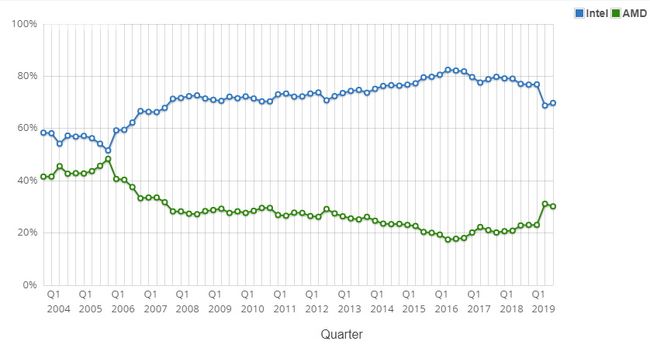What AMD or GF puts on marketing slide is irrelevant. Intel 14nm is clearly better than whatever GF has to offer.
This is easily seen on laptop battery life tests in which intel simply beat AMD even if the CPUs have the same TDP ranking. Why? Because intel idles at lower power use.
Yes, Raven Ridge was particularly bad in this area (inherently buggy probably). Picasso is a lot better.
But I'm pretty sure the discrepancy @ idle has nearly nothing to do with process. Intel just has years of more experience doing that stuff, has lower power states, does more power gating
Even more importantly, Intel has worked years with OEMs helping to implement better Firmware, BIOSes, etc to keep Idle Power down (not to mention OS optimisations) ...
Just look at power efficiency charts on notebookcheck.net for Lenovos with a really similar chassis (and battery) and both AMD and Intel processors.
T495 vs T490 power numbers
from this T495 review and
this E495 review (I added the i5 from the search-box below the table).
| Power Consumption (W) | Lenovo ThinkPad T495-20NKS01Y00
PRO R5 3500U, Vega 8, Samsung SSD PM981 MZVLB512HAJQ, IPS, 1920x1080, 14 | Lenovo ThinkPad T490-20N3S02L00
I7 8565U, GeForce MX250, Toshiba XG5 KXG50ZNV512G, IGZO IPS LED, 1920x1080, 14 | Lenovo ThinkPad T490-20N2004EGE
I5 8265U, UHD Graphics 620, Toshiba KXG5AZNV256G, IGZO IPS LED, 1920x1080, 14 | | Lenovo ThinkPad E490-20N8000RGE
8265U, UHD Graphics 620, SK hynix BC501 HFM256GDHTNG, IPS, 1920x1080, 14 |
|---|
| Idle Minimum | 5.1 | 2.16 | 2.34 | 4.1 | 2.76 |
| Idle Average | 7.7 | 5.04 | 5.22 | 5.86 | 5.96 |
| Idle Maximum | 10.7 | 8.64 | 8.82 | 6.36 | 6.57 |
| Load Average | 35.8 | 63.2 | 35.8 | 30.4 | 28.2 |
| Load Maximum | 43.2 | 67.5 | 47.3 | 50 | 43.6 |
I bolded the winning scores for both the T and E chassis separately. Now, some observations:
- So much about "the same " TDP between i5 and i7. i7 T490 uses almost twice the burst power briefly for 10% gain.
- T490 vs T495 Intel with i5 has similar power draw to AMD while scoring 13% better in Cinebench R15 ST burst load and is equal in Multi Threaded one.
- E490 vs E495 AMD in reverse has better idle numbers and slightly worse load ones compared to i5 . This in turn means 25% better MT performance for Ryzen while it's still 15% worse in ST.
Moving on to
Battery Life:
In battery life the AMD model actually does better than the Intel one:
Lenovo
T495 (Ryzen R5 3500U)

Lenovo
T490 (Core i7 8565U)
 TL;DR
TL;DR
12nm and 14nm+ actually seem quite similar. AMDs worse Idle number are probably more connected to other factors. We will know better once we have Surface Laptop 3 Reviews (as it's full-stack optimized by Microsoft).







